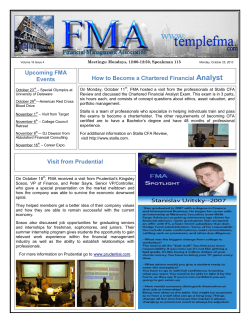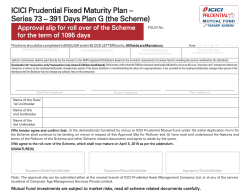
PRUDENTIAL INFLATION PLUS FUND 31 MAY 2015
PRUDENTIAL INFLATION PLUS FUND 31 MAY 2015 Since inception cumulative performance, distributions reinvested (A Class) Risk profile: R700 R637.22 Objective R600 Fund objective: R100 Initial Investment The primary objective is to outperform CPI by 5% (before fees) over a rolling 3-year period. The secondary objective is to reduce the risk of capital loss over any rolling 12-month period. Investor profile: Individuals looking for a low-to medium-risk multi-asset fund. Individuals and retirees who want to protect their investment from the detrimental effects of inflation over time. The recommended investment horizon is 3 years or longer. Investment mandate: R449.44 R400 R300 R200 The Fund invests in an actively managed, diversified combination of domestic and international assets where the asset allocation is tactically managed. The intended maximum limits are Equity 40%, Listed Property 25%, Offshore 25% plus additional 5% Africa (excl. SA). The Fund is managed to comply with regulations governing retirement fund investments (Regulation 28). Annualised performance ASISA category: South African - Multi-Asset - Low Equity Objective: CPI+5% p.a. over a rolling 3-year period # 9.5% 10.5% 10.4% 10.8% 11.5% 11.3% A Class Objective 5.8% -8.6% 94.9% 1.0 3.3 2.0 1.7% -0.6% 100.0% n/a n/a n/a Inception dates: X Class: 1 July 2011, B Class: 1 July 2002 Monthly volatility (annualised) Maximum drawdown over any period % of positive rolling 12 months Information ratio Sortino ratio Sharpe ratio Top holdings** 1. 2. 3. 4. 5. 6. 7. 8. 9. 10. Asset allocation Republic of SA ILB 2.60% 310328 (R210) Republic of SA ILB 5.50% 071223 (R197) Republic of SA Bond 10.50% 211226 (R186) Naspers Ltd Prudential Money Market Fund Prudential High Interest Fund PowerShares Senior Loan Portfolio ETF Republic of SA ILB 2.25% 310138 (I2038) Republic of SA ILB 2.00% 310125 (I2025) SPDR S&P 500 ETF 4.5% 4.1% 3.9% 3.3% 3.2% 3.1% 3.0% 3.0% 2.7% 2.6% 2015 Objective 12.5% 16.4% 15.3% 12.7% 13.9% 14.1% Risk measures Awards: Raging Bull: 2013 Morningstar: 2015 2013 B Class# 12.0% 15.8% n/a n/a n/a 15.1% 1 June 2001 R33 208 059 313 2011 X Class# 11.7% 15.5% 14.4% 11.9% 13.2% 14.1% Inception date: Fund size: 2009 A Class 1 year 3 years 5 years 7 years 10 years Since inception Marc Beckenstrater, Michael Moyle and David Knee 2007 2005 2003 2001 R100 Fund managers: ** R500 SA Inflation-linked Bonds SA Equity Foreign Equity SA Bonds (ex. Inflation-linked Bonds) SA Cash Foreign Bonds SA Listed Property Foreign Cash Fund's monthly asset class returns 22.7% 20.2% 16.3% 15.4% 9.9% 6.7% 6.3% 2.5% Foreign Equity Foreign Cash Foreign Bonds SA Cash SA Bonds (ex. Inflation-linked Bonds) SA Inflation-linked Bonds SA Equity SA Listed Property 2.1% 1.8% 0.9% 0.8% -0.7% -1.7% -4.3% -5.3% As at 31 March 2015 (updated quarterly) Income distributions Total distributions 12-month yield (A Class) 31 December 2014 (A Class) 30 June 2014 4.37 cpu 4.37 cpu 2.55% 2.43% Minimum lump sum investment Minimum monthly debit order (B Class) 31 December 2014 (B Class) 30 June 2014 5.66 cpu 5.55 cpu 3.21% 3.09% Initial fees (excl. VAT) If the income earned in the form of dividends and interest exceeds the total expenses, the Fund will make a distribution. (cpu = cents per unit) Investment options Prudential Financial adviser (if applicable) A Class X Class B Class R20 000 R1 000 pm R20 000 R1 000 pm R100 million n/a 0.00% 2.75% (max) 0.00% 2.75% (max) 0.00% 0.00% Annualised management fees (excl. VAT) Prudential* Financial adviser service fee** (if applicable) 1.25% 1.00% 0.60% 0.50% 0.50% 0.00% * Additional underlying foreign fund fees are dependent on the fund and are included in the TER ** Included in Prudential’s annual management fee above Total Expense Ratio (incl. VAT) TER Sources: Prudential South Africa & Morningstar 1.58% 1.31% 0.84% Prudential Inflation Plus Fund Page 1 of 2 PRUDENTIAL INFLATION PLUS FUND 31 MAY 2015 Fund commentary The FTSE/JSE All Share (ALSI) declined 4.0% on a total return basis in May 2015. The All Bond Index declined 0.7% and the Inflation-linked Bond Index declined 1.9%. The SA Listed Property Index declined 5.9% for the month. Cash returned 0.5%. The Rand weakened 3.0% against the US Dollar and 1.8% against the Euro in May 2015. The MSCI World Index gained 0.4% on a total return basis in US Dollar terms for the month. The Fund realised a total return of -1.3% for the month. The key detractors to performance this month came from the Fund's position in SA equity, inflation-linked bonds and SA listed property. This brings the one year performance of the Fund to 11.7% (after fees). The highest annual return recorded since inception of the Fund is 30.8% (on 30 April 2006) and the lowest is -6.3% (on 28 February 2008). The Fund has delivered a return of 14.1% per annum since inception (after fees) while CPI inflation has increased by 5.8% per annum. Sources: Prudential South Africa & Deutche Securities Glossary 12-month yield A measure of the Fund's income distributions as a percentage of the Fund's net asset value (NAV). This is calculated by summing the income distributions over a rolling 12-month period, then dividing by the sum of the NAV at the end of the period and any capital gains distributed over the same period. Annualised performance The average amount of money (total return) earned by an investment each year over a given time period. For periods longer than one year, total returns are expressed as compounded average returns on a yearly basis. Cumulative performance graph This illustrates how an initial investment of R100 or N$100 (for example) placed into the Fund would change over time, taking ongoing fees into account, with all distributions reinvested Fund's monthly asset class returns The percentage return that each asset class the Fund is invested in, has contributed to the overall return of the Fund. Income distribution The dividend income and/or interest income that is generated by the underlying Fund investments and that is periodically declared and distributed to investors in the Fund after all annual service fees. Information ratio Measures the Fund’s active return (Fund return in excess of the benchmark) divided by the amount of risk that the manager takes relative to the benchmark. The higher the information ratio, the higher the active return of the Fund, given the amount of risk taken and the more consistent the manager. This is calculated over a 3-year period. Intended maximum limits This indicates the Fund’s intended maximum exposure to an asset class. These limits may be reviewed subject to the Fund’s Supplemental Deed and/or Regulation 28 for those Funds managed in accordance with Regulation 28 of the Pension Funds Act. Maximum drawdown The largest drop in the Fund’s cumulative total return from peak to trough over any period. Monthly volatility (annualised) Also known as standard deviation. This measures the amount of variation or difference in the monthly returns on an investment. The larger the annualised monthly volatility, the more the monthly returns are likely to vary from the average monthly return (i.e. the more volatile the investment). Percentage of positive rolling 12 months The percentage of months, since inception, that the Fund has shown a positive return over a rolling 12-month period. Regulation 28 The South African retirement fund industry is governed by the Pension Funds Act, No 24 of 1956. Regulation 28 of the Pension Funds Act prescribes the maximum limits in asset classes that an approved retirement fund may invest in. Sharpe ratio The Sharpe ratio is used to measure how well the return of an asset compensates the investor for the risk taken. The higher the Sharpe ratio the better the Fund’s historical risk-adjusted performance has been. This is calculated by taking the difference between the Fund’s annualised return and the risk-free (cash) rate, divided by the standard deviation of the Fund’s returns. This is calculated over a 3-year period. Sortino ratio This is calculated by taking difference between the Fund’s annualised return and the risk-free (cash) rate, divided by the downside deviation of the Fund’s returns i.e. the ”bad” volatility. A high Sortino ratio indicates a low risk of large losses occurring in the Fund. This is calculated over a 3-year period. Total Expense Ratio (TER) This shows the charges, levies and fees relating to the management of the portfolio and is expressed as a percentage of the average net asset value of the portfolio, calculated for the year to the end of the most recent completed quarter. A higher TER does not necessarily imply a poor return, nor does a low TER imply a good return. The current TER cannot be regarded as an indication of future TERs. Unit class Prudential’s Funds are offered in different unit classes to allow different types of investors (individuals and institutions) to invest in the same fund. Different investment minimums and fees apply to different unit classes. A Class: for individuals only. B & D Class: retirement funds and other large institutional investors only. X Class: the special fee class that was made available to investors that were invested in the Dividend Income Feeder Fund. How to invest Call us at 0860 105 775 or visit our website at www.prudential.co.za. Application forms and all documentation required by FICA must be faxed to +27 11 263 61 43 or e-mailed to instructionsa@myprudential.co.za. Cheques must be made payable to Prudential Inflation Plus Fund and deposited into the following bank account: Standard Bank, Claremont, Account number: 072508434, Branch code: 025109. Disclaimer Prudential Portfolio Managers Unit Trusts Ltd (Registration number: 1999/0524/06) is an approved CISCA management company (#29). Assets are managed by Prudential Investment Managers (South Africa) (Pty) Ltd, which is an approved discretionary Financial Services Provider (#45199). The Trustee’s/Custodian details are: Standard Bank of South Africa limited – Trustees Services & investor Services. 20th Floor, Main Tower, Standard Bank Centre, Heerengracht, Cape Town. Collective Investment Schemes (unit trusts) are generally medium-to long-term investments. Past performance is not necessarily a guide to future investment performance. Unit trust prices are calculated on a net asset value basis. This means the price is the total net market value of all assets of the unit trust fund divided by the total number of units of the fund. Any market movements – for example in share prices, bond prices, money market prices or currency fluctuations - relevant to the underlying assets of the fund may cause the value of the underlying assets to go up or down. As a result, the price of your units may go up or down. Unit trusts are traded at the ruling forward price of the day, meaning that transactions are processed during the day before you or the Manager know what the price at the end of the day will be. The price and therefore the number of units involved in the transaction are only known on the following day. The unit trust fund may borrow up to 10% of the fund value, and it may also lend any scrip (proof of ownership of an investment instrument) that it holds to earn additional income. A Prudential unit trust fund may consist of different fund classes that are subject to different fees and charges. Where applicable, the Manager will pay your financial adviser an agreed standard ongoing adviser fee, which is included in the overall costs of the fund. A Collective Investment Schemes (CIS) summary with all fees and maximum initial and ongoing adviser fees is available on our website. One can also obtain additional information on Prudential products on the Prudential website. The Fund may hold foreign securities including foreign CIS funds. As a result, the fund may face material risks. The volatility of the fund may be higher and the liquidity of the underlying securities may be restricted due to relative market sizes and market conditions. The fund’s ability to settle securities and to repatriate investment income, capital or the proceeds of sales of securities may be adversely affected for multiple reasons including market conditions, macro-economic and political circumstances. Further, the return on the security may be affected (positively or negatively) by the difference in tax regimes between the domestic and foreign tax jurisdictions. The availability of market information and information on any underlying sub-funds may be delayed. The Manager may, at its discretion, close your chosen unit trust fund to new investors and to additional investments by existing investors to make sure that it is managed in accordance with its mandate. It may also stop your existing debit order investment. The Manager makes no guarantees as to the capital invested in the fund or the returns of the fund. Excessive withdrawals from the fund may place the fund under liquidity pressure and, in certain circumstances; a process of ring fencing withdrawal instructions may be followed. Fund prices are published daily on the Prudential website. These are also available upon request. The performance is calculated for the portfolio. Individual investor performance may differ as a result of initial fees, the actual investment date, the date of reinvestment and dividend withholding tax. Purchase and repurchase requests must be received by the Manager by 13h30 (11h30 for the Money Market Fund) SA time each business day. All online purchase and repurchase transactions must be received by the Manager by 10h30 (for all Funds) SA time each business day. An electronic copy of this document is available at www.prudential.co.za Prudential Inflation Plus Fund Page 2 of 2
© Copyright 2025











